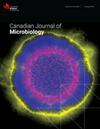大麻二酚(CBD)(一种大麻植物衍生物)对白色念珠菌生长和生物膜形成的影响。
IF 1.6
4区 生物学
Q4 BIOTECHNOLOGY & APPLIED MICROBIOLOGY
Canadian journal of microbiology
Pub Date : 2025-01-01
Epub Date: 2024-10-17
DOI:10.1139/cjm-2024-0034
引用次数: 0
摘要
本研究旨在评估大麻二酚(CBD)对白僵菌的抗真菌活性。用不同浓度(0 至 20 毫克/毫升)的大麻二酚处理酵母细胞一次或两次后,白僵菌的生长显著下降(p < 0.05),细胞浓度从对照组的 5.1 × 106 个/毫升下降到接触 20 微克/毫升大麻二酚后的 1.8 × 106 个/毫升。在两次接触 CBD 后,生长减少的幅度更大。两次接触 20 µg/mL CBD 后,细胞浓度仅为 1.1 × 106 cells/mL。与对照组相比,白僵菌的生长减少得到了 CFU 数量减少和 MTT 值降低的证实。酵母到菌丝的转化率显著下降(p < 0.001),从对照组的 20 ± 0.2% 降至接触 20 µg/mL CBD 后的 2 ± 0.5%,这也证实了生长抑制作用。暴露于 CBD 后,生物膜的形成也明显减少。浓度为 10 和 20 µg/mL 的 CBD 可通过凋亡/坏死途径促进白僵菌的死亡。总之,我们的研究结果表明,大麻衍生物 CBD 可用于控制白僵菌感染,包括口腔念珠菌病。本文章由计算机程序翻译,如有差异,请以英文原文为准。
Effect of cannabidiol (CBD), a cannabis plant derivative, against Candida albicans growth and biofilm formation.
Highlights: Cannabidiol (CBD) decreases the growth of C. albicans. CBD inhibits the yeast-to-hyphae transition. CBD reduces biofilm formation by C. albicans. CBD induces C. albicans death through necrosis.
求助全文
通过发布文献求助,成功后即可免费获取论文全文。
去求助
来源期刊
CiteScore
4.80
自引率
0.00%
发文量
71
审稿时长
2.5 months
期刊介绍:
Published since 1954, the Canadian Journal of Microbiology is a monthly journal that contains new research in the field of microbiology, including applied microbiology and biotechnology; microbial structure and function; fungi and other eucaryotic protists; infection and immunity; microbial ecology; physiology, metabolism and enzymology; and virology, genetics, and molecular biology. It also publishes review articles and notes on an occasional basis, contributed by recognized scientists worldwide.

 求助内容:
求助内容: 应助结果提醒方式:
应助结果提醒方式:


